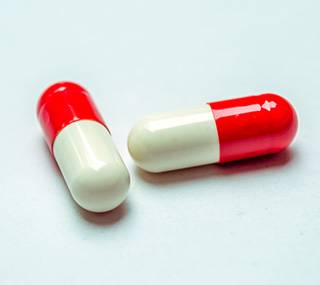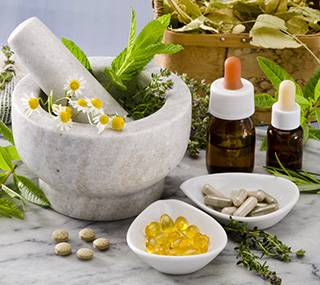Herbal medicines and essential oils
What are herbal medicines?
A herbal medicine is a medicine in which the active substance is exclusively one or more herbal substances, a plant-based preparation, or a combination of several herbal substances or plant-based preparations.(Art. L. 5121-1, Paragraph 16 French Public Health Code)
It may take the form of a pharmaceutical speciality, a pharmaceutical preparation (either pharmacy-compounded or pharmacy-prepared), or a herbal drug.
Herbal medicines in pharmaceutical product form
A pharmaceutical speciality is a medicine that has been prepared in advance, is presented in specific packaging, and characterised by a specific name.A herbal pharmaceutical speciality is a medicine in which the active substance is of plant origin, i.e. manufactured from one or more plants.
The active substance may be concentrated, e.g. in extract form, manufactured from a part of the plant (leaves, root, etc.), or from the whole plant.
Its release to the French market is subject to the granting of a marketing authorisation (MA) or registration by ANSM.
Herbal medicines in pharmacy-compounded or pharmacy-prepared preparations
Preparations are medicines prepared in pharmacies for the specific needs of one or more patients.There are two different types of preparations made from medicinal herbs, extracts or essential oils.
Pharmacy-compounded preparation: prepared for a specific patient according to a medical prescription, due to the lack of an available or suitable product. They are prepared by a community pharmacy or by a hospital pharmacy.
Pharmacy-prepared preparations: these preparations are included in the pharmacopoeia or national formulary, and are prepared in community pharmacies to be dispensed directly to the pharmacies’ patients.
Specific case: herbal teas
Community pharmacies may prepare herbal tea blends in the form of pharmacy-prepared preparations, according to the conditions set out in the national formulary monograph.
All preparations – whether pharmacy-compounded or pharmacy-prepared – are produced and dispensed under a pharmacist’s responsibility in accordance with Good Preparation Practice.
All preparations – whether pharmacy-compounded or pharmacy-prepared – are produced and dispensed under a pharmacist’s responsibility in accordance with Good Preparation Practice.
Key messages
A blend of medicinal herbs has a status of a preparation.
Medicinal herbs sold in bulk are not considered preparations.
Medicinal herbs sold in bulk are not considered preparations.
Herbal drugs
Herbal drugs are medicinal herbs, aromatics and their derivatives, which are dispensed in bulk, as is or in the form of preparations (extracts or essential oils).They may be used whole or as parts of the plant part form and have medicinal properties.
The French Pharmacopoeia specifies that they may also be used in food, as condiments, or for hygiene purposes.
Where can herbal medicines be obtained?
Herbal medicines, like all other medicines, are dispensed by community pharmacies, or through the websites of registered pharmacy dispensaries.Medicinal herbs may be used for manufacturing medicines, but may also be dispensed in bulk or in the form of pharmaceutical preparations by community pharmacy.
Some medicinal herbs having a therapeutic use are identified in the list published in the French Pharmacopoeia, and are reserved for sale in pharmacies: the sale of medicinal herbs listed in the French Pharmacopeia is reserved for pharmacists, subject to exemptions set out by order (Art L.4211-1 Paragraph 5 of the French Public Health Code).
Medicines and the Internet
Due to their nature and status, herbal medicines are particularly exposed to the risk of counterfeiting.Essential oils
What are essential oils?
Essential oils are deemed to be herbal “preparations”. (Article R5121 of the French Public Health Code)They are defined as “odorous products, usually of complex composition, obtained from a botanically defined plant raw material by steam distillation, dry distillation, or a suitable mechanical process without heating".
- Essential oils are most often separated from aqueous phase by a physical process that does not cause a significant change in its composition” (European Pharmacopoeia definition).
- Depending on their use and claims, essential oils are subject to cosmetic product, biocide (sanitising sprays), or herbal medicine regulations.
- An essential oil is deemed to be a medicine if it is described as having properties for treating or preventing human diseases, or when it has a pharmacological, immunological, or metabolic action.
- It may also be used as an excipient (e.g. aroma) in the formula of a medicine.
- In pharmacies, essential oils may be dispensed in the form of pharmacy-compounded preparations or as is.
How can essential oils be used safely?
The active substances in essential oils may give rise to a risk of serious adverse reactions following inappropriate and uncontrolled use.It is recommended to ask the pharmacist for advice
- prior medical advice is required for the use of essential oils for pregnant women and for children, particularly when they are used orally;
- essential oils pose an increased risk of toxicity if misused: follow the instructions for use;
- essential oils must not be used for prolonged periods (beyond a few days) without medical advice;
- if no improvement is observed after a few days of use, seek medical advice.
Essential oils for which sales are restricted to pharmacies
Essential oils dispensed only in pharmacies must comply with the pharmaceutical quality described in the European Pharmacopeia or in the French Pharmacopoeia. This reference describes the exact scientific name of the essential oil, its chemotype where applicable, and its chemical composition.These fifteen essential oils are identified as having a negative benefit-risk ratio
It is preferable not to dispense them. They are only available in the pharmaceutical circuit due to their neurotoxic (wormwood, arborvitae, common sage), irritant (common saving, mustard), phototoxic (rue) or carcinogenic (sassafras) properties:- Common Wormwood (Artemisia absinthium L.)
- Roman Wormwood (Artemisia pontica L.)
- Mugwort (Artemisia vulgaris L.)
- White Wormwood (Artemisia herba alba Asso L.)
- Tree Wormwood (Artemisia arborescens L.)
- Arborvitae or Northern White-Cedar (Thuya occidentalis L.)
- Korean Arborvitae (Thuya Koraenensis Nakai), or “Cedar Leaf”
- Hyssop (Hyssopus officinalis L.)
- Common Sage (Salvia officinalis L.)
- Tansy (Tanacetum vulgare L.) Western Red Cedar (Thuya plicata Donn ex D. Don.)
- Sassafras (Sassafras albidum [Nutt.] Nees)
- Common Savin (Juniperus sabina L.)
- Rue (Ruta graveolens L.)
- Mexican Tea (Chenopodium ambrosioides and Chenopodium anthelminticum L.)
- Mustard Greens (Brassica juncea [L.] Czernj. et Cosson).
Essential oils not restricted to the pharmaceutical circuit
Essentials oils which are not restricted to the pharmaceutical circuit are available over-the-counter, and distributed by various circuits (pharmacist, specialist retail outlets, etc.).They must not claim any therapeutic indications insofar as their composition is not guaranteed with regard to their potential therapeutic effect.
The online sale of medicines is regulated. To find out more, refer to the file on “Online sale of medicines”.







